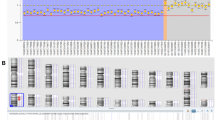Summary
Although the retinoblastoma gene has been isolated and sequenced, the difference in penetrance and expressivity among families has not yet been fully explained. Balanced chromosomal insertion involving the 13q14 regions has been shown to account for some families with several unaffected carriers. Since there could be cases with karyotypically undetectable insertions, we tested whether this mechanism was general enough to explain the whole difference in expressivity among families. Using 166 pedigrees, reported in nine series available in the literature (including our own), we conclude that balanced insertion cannot entirely explain the familial data, even if we allow for a reduced viability of unbalanced gametes. Other mechanisms are proposed and discussed in this paper.
Similar content being viewed by others
References
Auerbach C (1956) A possible case of delayed mutation in man. Ann Hum Genet 20:266–269
Bonaïti-Pellié C, Briard-Guillemot ML (1980) Excess of cancer deaths in grandparents of patients with retinoblastoma. J Med Genet 17:95–101
Bonaïti-Pellié C, Briard-Guillemot ML (1981) Segregation analysis in hereditary retinoblastoma. Hum Genet 57:411–419
Bonaïti C, Demenais F (1980) Diseases having two classes of severity: estimation of the proportions of each manifestation by maximum likelihood. Biometrics 36:447–460
Briard-Guillemot ML, Bonaïti-Pellié C, Feingold J, Frézal J (1974) Etude génétique du rétinoblastome. Humangenetik 24:271–284
Cavenee WK, Dryja TP, Phillips RA, Benedict WF, Godbout R, Gallie BL, Murphree AL, Strong LC, White RL (1983) Expression of recessive alleles by chromosomal mechanisms in retinoblastoma. Nature 305:779–784
Dryja TP, Cavenee W, White R, Rapaport JM, Peterson R, Albert DM, Bruns GAP (1984) Homozygosity of chromosome 13 in retinoblastoma. N Engl J Med 310:550–553
Ellsworth RM (1969) The practical management of retinoblastoma. Trans Am Ophthalmol Soc 67:462–534
Falls HF, Neel JV (1951) Genetics of retinoblastoma. Arch Ophthalmol 46:367–389
Friend SH, Bernards R, Rogelji S, Weinberg RA, Rapaport JM, Albert DM, Dryja TP (1986) A human DNA segment with properties of the gene that predisposes to retinoblastoma and osteosarcoma. Nature 323:643–646
Fung YKT, Murphree AL, T'Ang A, Qiazn J, Hinrichs SH, Benedict WF (1987) Structural evidence for the authenticity of the human retinoblastoma gene. Science 236:1657–1661
Godbout R, Dryja TP, Squirre J, Gallie BL, Phillips RA (1983) Somatic inactivation of genes on chromosome 13 is a common event in retinoblastoma. Nature 304:451–453
Hermann J (1976) Delayed mutation as a cause of retinoblastoma: application to genetic counseling. Birth Defects 12:79–90
Hermann J (1977) Delayed mutation model: carotid body tumors and retinoblastoma. In: Mulvihill JJ, Miller RW, Fraumeni JF (eds) Genetics of human cancer. Raven Press, New York, pp 417–438
Knudson AG (1971) Mutation and cancer: statistical study of retinoblastoma. Proc Natl Acad Sci USA 68:820–823
Knudson AG (1983) Model hereditary cancers of man. Prog Nucleic Acids Res Mol Biol 29:17–25
Lee WH, Bookstein R, Hong F, Young LH, Shew JY, Lee EYHP (1987) Human retinoblastoma susceptibility gene: cloning, identification and sequence. Science 235:1394–1399
Macklin MT (1960) A study of retinoblastoma in Ohio. Am J Hum Genet 12:1–43
Matsunaga E (1976) Hereditary retinoblastoma: penetrance, expressivity and age at onset. Hum Genet 33:1–15
Matsunaga E (1978) Hereditary retinoblastoma: delayed mutation or host resistance? Am J Hum Genet 30:406–424
Matsunaga E (1980) Retinoblastoma: host resistance and 13q-chromosomal deletion. Hum Genet 56:53–58
Matsunaga E, Ogyu H (1976) Retinoblastoma in Japan: follow up survey of sporadic cases. Jpn J Ophthalmol 20:266–282
Neel JV (1962) Mutations in the human population. In: Burdette WJ (ed) Methodology in human genetics. Holden Day, San Francisco, pp 203–279
Riccardi VM, Hittner HM, Francke U, Pippin S, Holmquist GP, Kretzer FL, Ferrell R (1979) Partial triplication and deletion of 13q: study of a family presenting with bilateral retinoblastomas. Clin Genet 15:332–345
Rivera H, Turleau C, Grouchy J de, Junien C, Despoisses S, Zücker JM (1981) Retinoblastoma -del(13q14): report of two patients, one with a trisomic sib due to maternal insertion. Gene dosage effect for esterase D. Hum Genet 59:211–214
Schappert-Kimmijser J, Hemmes GD, Nijland R (1966) The heredity of retinoblastoma. Ophthalmologica 151:197–213
Scheffer H, Meerman GJ te, Kruize YCM, Berg AHM van den, Penninga DP, Tan KEWP, Kinderen DJ der, Buys CHCM (1989) Linkage analysis of families with hereditary retinoblastoma: non-penetrance of mutation, revealed by combined use of markers within and flanking the Rb1 gene. Am J Hum Genet 45:252–260
Sorsby A (1972) Bilateral retinoblastoma: a dominantly inherited affection. Br Med J 2:580–583
Sparkes RS, Murphree AL, Lingua RW, Sparkes MC, Field LL, Funderburk SJ, Benedict WF (1983) Gene for hereditary retinoblastoma assigned to human chromosome 13 by linkage analysis of esterase D. Science 219:971–973
Strong LC, Riccardi VM, Ferrell RE, Sparkes RS (1981) Familial retinoblastoma and chromosome 13 deletion transmitted via an insertional translocation. Science 213:1501–1503
Tucker DP, Streinberg AG, Cogan DG (1957) Frequency of genetic transmission of sporadic retinoblastoma. Arch Ophthalmol 57:532–535
Turleau C, Grouchy J de, Chavin-Colin F, Despoisses S, Leblanc A (1983) Two cases of del(13q)-retinoblastoma and two cases of partial trisom due to familial insertion. Ann Génét (Paris) 26:158–160
Vogel F (1957) Neue Untersuchungen zur Genetik des Retinoblastoms. Z Mensch Vererb Konstit Lehre 34:205–236
Vogel F (1979) Genetics of retinoblastoma. Hum Genet 52:1–54
Author information
Authors and Affiliations
Rights and permissions
About this article
Cite this article
Bonaïti-Pellié, C., Clerget-Darpoux, F. & Babron, MC. Hereditary retinoblastoma: can balanced insertion entirely explain the differences of expressivity among families?. Hum Genet 86, 203–208 (1990). https://doi.org/10.1007/BF00197706
Received:
Issue Date:
DOI: https://doi.org/10.1007/BF00197706




